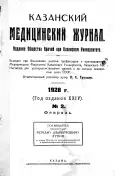Central nervous barrier permeability in mental and nervous diseases. S. and L. Prusak (Warsz. Czasop. Lek., 1927, nos. 3-4)
- Authors: Weinberg M.
- Issue: Vol 24, No 2 (1928)
- Pages: 260-260
- Section: Articles
- URL: https://bakhtiniada.ru/kazanmedj/article/view/90226
- DOI: https://doi.org/10.17816/kazmj90226
- ID: 90226
Cite item
Full Text
Abstract
The study of the permeability of the central nerve barrier (barrière hémato-encéphalique Sternow'a and Gautier) is increasingly acquiring the rights of citizenship among other clinical methods. For this study, it is possible to use either such substances that in a healthy person never pass into the cerebrospinal fluid and whose presence in the latter indicates damage to the barrier (Weil-Kafki gemolysin test, Flatau's chromo-neuroscopic test), or such that in pathological conditions pass either in increased versus normal amounts or in decreased amounts. The second category includes Walter's bromine test. Walter uses sodium bromide, the content of which he determines colorimetrically with gold chloride. Having determined by this method the bromine content in the cerebrospinal fluid and in the blood serum, he divides the figure expressing the bromine saturation of the blood serum by the figure expressing the bromine content in the cerebrospinal fluid, and by this he determines the barrier permeability index.
Keywords
Full Text
##article.viewOnOriginalSite##About the authors
M. Weinberg
Author for correspondence.
Email: info@eco-vector.com
Russian Federation
References
Supplementary files





